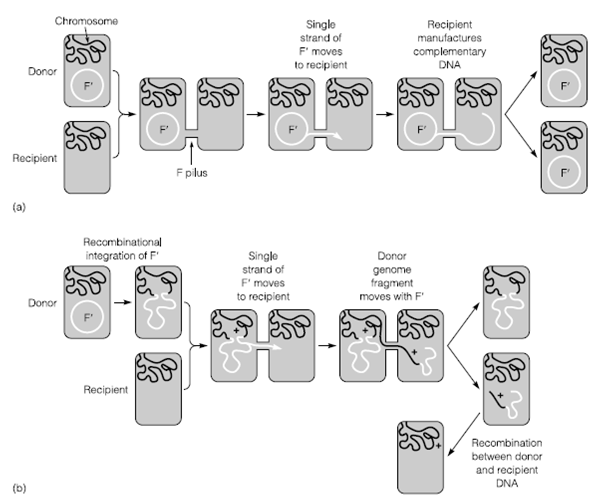Transformation
Although conjugation and transduction provide simple ways to introduce genes into microorganisms both are time-consuming processes. The most generally used way of introducing DNA into Bacteria in today’s laboratory is by transformation.

Figure: Mating of donor and recipient: (a) between an F+ strain and recipient; (b) between an Hfr strain and recipient.
Most routine molecular biology experiments result in the generation of plasmids in the form of DNA libraries cloning experiments or preparation of DNA constructs for other experiments.
The method of transformation is well defined but the mechanism is poorly under- stood. In E. coli in order to make the cells available for manipulation plasmid-free cells are grown to mid log phase and then washed in a cold magnesium chloride solution to remove traces of growth medium. The high concentration of washed cells is suspended in cold calcium chloride. At this stage the cells are competent a state mimicking a physiological state in that the Bacteria are able to take up DNA from their environment. It is thought that this is a starvation response and perhaps the influx of external DNA may provide an extra gene which might help the cell survive. In the laboratory the plasmid to be transformed is added to the competent cells. The plasmid remains in solution until the cold cells are suddenly heat shocked through raising the temperature to 42?C. the Only small percentage of the cells take up plasmid DNA as a result of the heat shock and all the cells are in a weakened state. A rich recovery medium is added and then the cells are plated out on a selective medium after incubation. The cells which have successfully taken up the plasmid are known as transformants. Not all Bacteria can be transformed in the laboratory but a same protocol is used to generate Bacillus subtilis transformants although they can only take up linear DNA and must maintain the acquired genes through recombination into their chromosomes. However, the way in which either plasmid DNA in E. coli or linear DNA in B. subtilis crosses the cell membrane intact or in what form it does so is currently the subject of speculation.